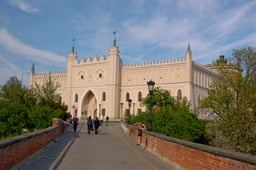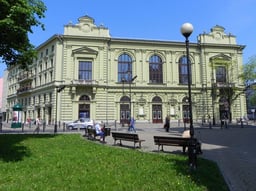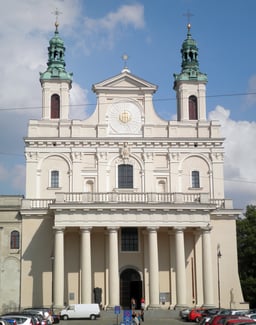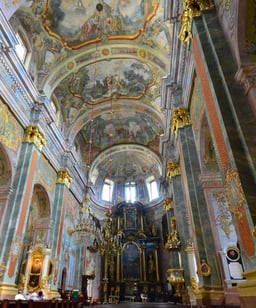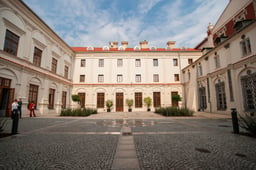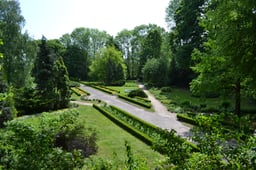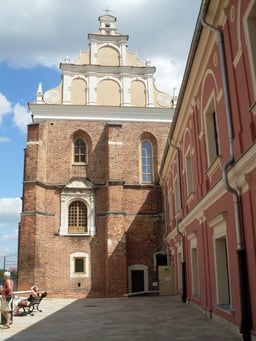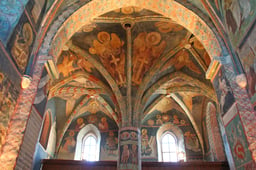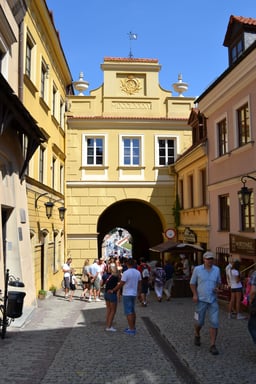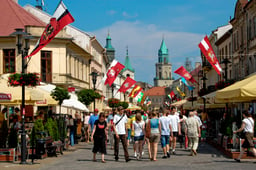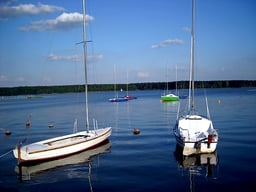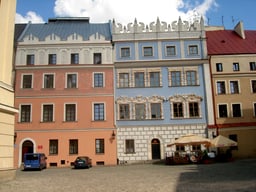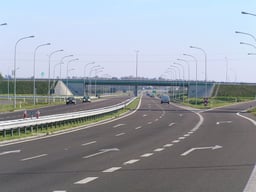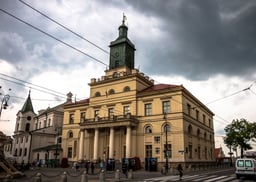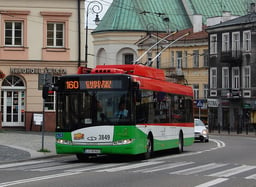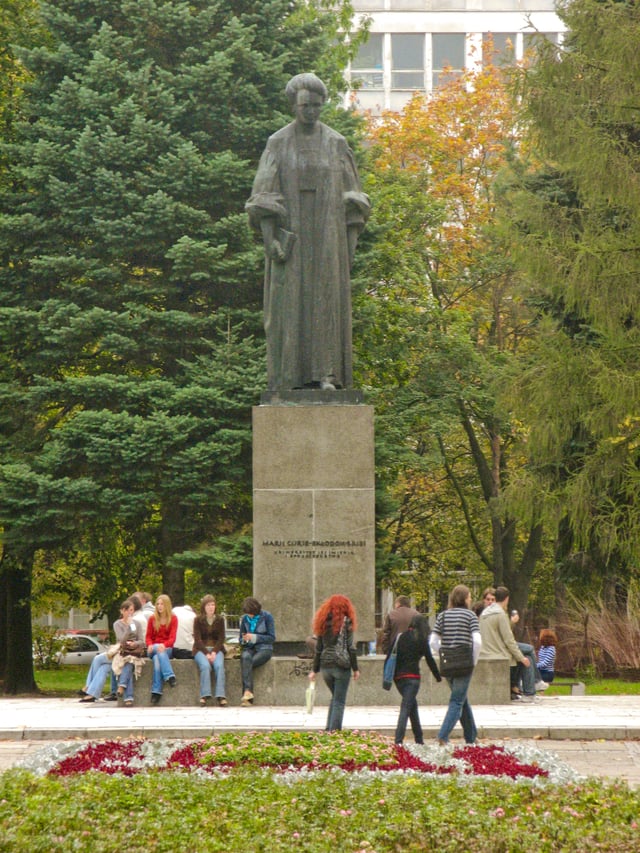Lublin
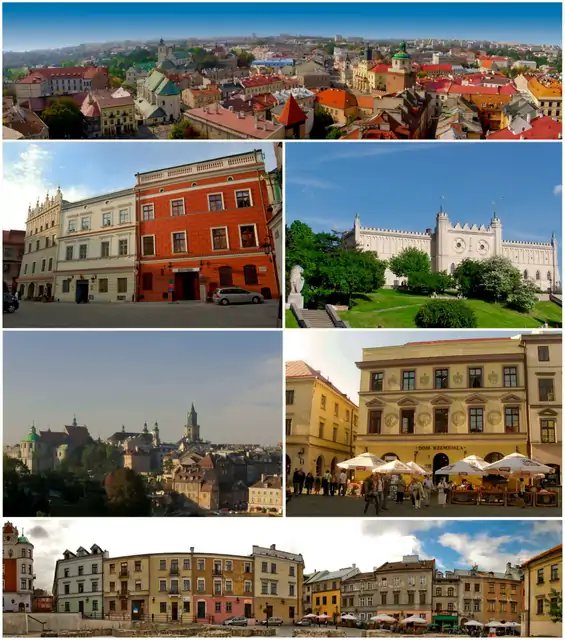
Lublin

Lublin | |
|---|---|
City | |
| Motto(s): | |
| Coordinates:51°14′53″N 22°34′13″E [54] | |
| Country | |
| Voivodeship | |
| Powiat | City County (Capital of Lublin County but not part of it) |
| Established | before 12th century |
| Town rights | 1317 |
| Government | |
| • Mayor | Krzysztof Żuk |
| Area | |
| • City | 147 km2(57 sq mi) |
| Population (31 December 2018) | |
| • City | 339,682 |
| • Metro | 664,000 |
| Time zone | UTC+1 (CET) |
| • Summer (DST) | UTC+2 (CEST) |
| Postal code | 20-001 to 20-999 |
| Area code(s) | +48 81 |
| Car plates | LU |
| Website | http://www.um.lublin.pl/ [55] http://www.lublin.eu/en [56] |
Lublin (UK: /ˈlʊblɪn/,[3] US: /ˈluːblɪn/,[4] Polish: [ˈlublin] (listen)) is the ninth-largest city in Poland and the second-largest city of Lesser Poland. It is the capital and the center of Lublin Voivodeship (province) with a population of 339,682 (December 2018).[2] Lublin is the largest Polish city east of the Vistula River and is about 170 km (106 mi) to the southeast of Warsaw by road.
One of the events that greatly contributed to the city's development was the Polish-Lithuanian Union of Krewo in 1385. Lublin thrived as a centre of trade and commerce due to its strategic location on the route between Vilnius and Kraków; the inhabitants had the privilege of free trade in the Grand Duchy of Lithuania. The Lublin Parliament session of 1569 led to the creation of a real union between the Crown of the Kingdom of Poland and the Grand Duchy of Lithuania, thus creating the Polish-Lithuanian Commonwealth. Lublin witnessed the early stages of Reformation in the 16th century. A Calvinist congregation was founded and groups of radical Arians appeared in the city, making it an important global centre of Arianism. At the turn of the century, Lublin was recognized for hosting a number of outstanding poets, writers, and historians of the epoch.[5]
Until the partitions at the end of the 18th century, Lublin was a royal city of the Crown Kingdom of Poland. Its delegates and nobles had the right to participate in the royal election. In 1578, Lublin was chosen as the seat of the Crown Tribunal, the highest appeal court in the Polish–Lithuanian Commonwealth, and for centuries, the city has been flourishing as a centre of culture and higher learning, with Kraków, Warsaw, Poznań, and Lwów.
Although Lublin was not spared from severe destruction during World War II, its picturesque and historical Old Town has been preserved. The district is one of Poland's official national historic monuments (Pomnik historii), as designated May 16, 2007, and tracked by the National Heritage Board of Poland.[6]
The city is viewed as an attractive location for foreign investment, and the analytical Financial Times Group has found Lublin to be one of the best cities for business in Poland.[7] The Foreign Direct Investment ranking placed Lublin second among larger Polish cities in the cost-effectiveness category. Lublin is noted for its green spaces and a high standard of living.[8]
Lublin | |
|---|---|
City | |
| Motto(s): | |
| Coordinates:51°14′53″N 22°34′13″E [54] | |
| Country | |
| Voivodeship | |
| Powiat | City County (Capital of Lublin County but not part of it) |
| Established | before 12th century |
| Town rights | 1317 |
| Government | |
| • Mayor | Krzysztof Żuk |
| Area | |
| • City | 147 km2(57 sq mi) |
| Population (31 December 2018) | |
| • City | 339,682 |
| • Metro | 664,000 |
| Time zone | UTC+1 (CET) |
| • Summer (DST) | UTC+2 (CEST) |
| Postal code | 20-001 to 20-999 |
| Area code(s) | +48 81 |
| Car plates | LU |
| Website | http://www.um.lublin.pl/ [55] http://www.lublin.eu/en [56] |
History
Archaeological finds indicate a long presence of cultures in the area. A complex of settlements started to develop on the future site of Lublin and in its environs in the sixth to seventh centuries. Remains of settlements dating back to the sixth century were discovered in the center of today's Lublin on Czwartek ("Thursday") Hill.
The period of the early Middle Ages was marked by intensification of habitation, particularly in the areas along river valleys. The settlements were centered around the stronghold on Old Town Hill, which was likely one of the main centers of Lendians tribe. When the tribal stronghold was destroyed in the 10th century, the center shifted to the northeast, to a new stronghold above Czechówka valley and, after the mid-12th century, to Castle Hill. At least two churches are presumed to have existed in Lublin in the early medieval period. One of them was most probably erected on Czwartek Hill during the rule of Casimir the Restorer in the 11th century.[9] The castle became the seat of a Castellan, first mentioned in historical sources from 1224, but was quite possibly present from the start of the 12th or even 10th century. The oldest historical document mentioning Lublin dates from 1198, so the name must have come into general use some time earlier.[9]
The location of Lublin at the eastern borders of the Polish lands gave it military significance. During the first half of the 13th century, Lublin was a target of attacks by Mongols, Ruthenians, and Lithuanians, which resulted in its destruction.[9] It was also ruled by Kingdom of Galicia–Volhynia between 1289 and 1302.[9] Lublin was founded as a town by Władysław I the Elbow-high or between 1258 and 1279 during the rule of prince Bolesław V the Chaste.[9] Casimir III the Great, appreciating the site's strategic importance, built a masonry castle in 1341 and encircled the city with defensive walls.[10] From 1326, if not earlier, the stronghold on Castle Hill included a chapel in honor of the Holy Trinity. A stone church dated to 1335-1370 exists to this day.[9]
Jagiellonian Poland
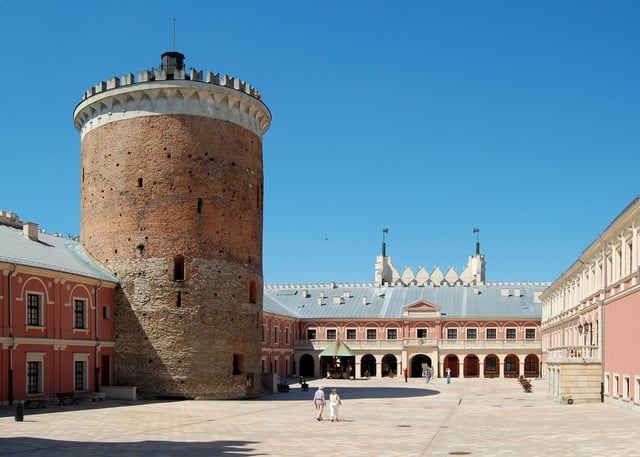
Castle courtyard with a fortified keep

Neogothic façade of Lublin Castle
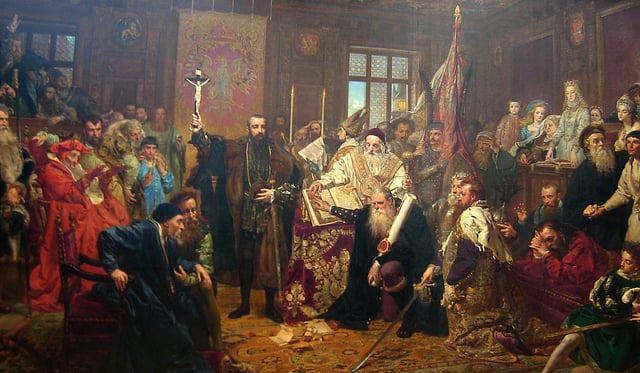
Union of Lublin, painting by Jan Matejko at the Lublin Museum
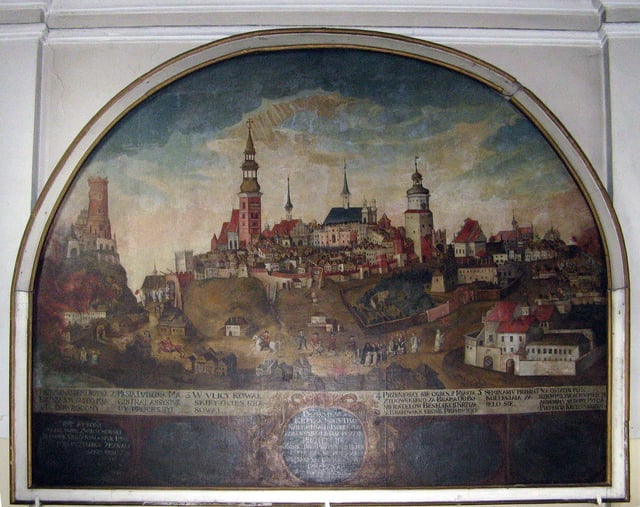
Great Fire of Lublin (1719)
In 1392, the city received an important trade privilege from king Władysław II Jagiełło. With the coming of peace between Poland and Lithuania, it developed into a trade centre, handling a large portion of commerce between the countries. In 1474, the area around Lublin was carved out of Sandomierz Voivodeship and combined to form the Lublin Voivodeship, the third voivodeship of Lesser Poland.
During the 15th and 16th centuries, the town grew rapidly. The largest trade fairs of the Polish–Lithuanian Commonwealth were held in Lublin. During the 16th century, the noble parliaments (sejm) were held in Lublin several times. On 26 June 1569, one of the most important proclaimed the Union of Lublin, which united Poland and Lithuania. The Lithuanian name for the city is Liublinas. Lublin was one of the most influential cities[9] of the state enjoyed voting rights during the royal elections in Poland.
Some of the artists and writers of the 16th century Polish renaissance lived and worked in Lublin, including Sebastian Klonowic and Jan Kochanowski, who died in the city in 1584. In 1578, the Crown Tribunal, the highest court of the Lesser Poland region, was established in Lublin.[9]
Since the second half of the 16th century, Protestant Reformation movements devolved in Lublin, and a large congregation of Polish Brethren was present in the city. One of Poland's most important Jewish communities was established in Lublin around this time.[9] Jews established a widely respectedyeshiva, Jewish hospital, synagogue, cemetery, and education centre (kahal) and built the Grodzka Gate (known as the Jewish Gate) in the historic district. Jews were a vital part of the city's life until the Holocaust, during which they were relocated to the infamous Lublin Ghetto and ultimately murdered.[9]
In the 17th century, the town declined due to a Russo-Ukrainian invasion in 1655 and a Swedish invasion during the Northern Wars.
19th century to the present
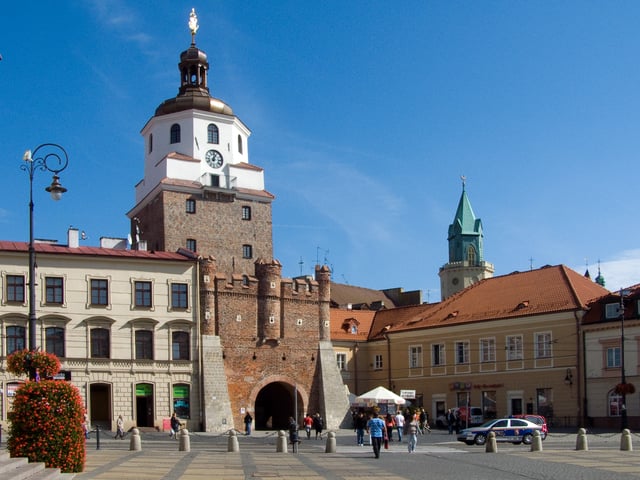
Cracow Gate in the Old Town is among the city's most recognisable landmarks.
After the third of the Partitions of Poland in 1795, Lublin was located in the Austrian empire, then since 1809 in the Duchy of Warsaw, and then since 1815 in the Congress Poland under Russian rule.
At the beginning of the 19th century, new squares, streets, and public buildings were built. In 1877, a railway connection to Warsaw and Kovel and Lublin Station were constructed, spurring industrial development. Lublin's population grew from 28,900 in 1873 to 50,150 in 1897 (including 24,000 Jews).[11]
Russian rule ended in 1915, when the city was occupied by German and Austro-Hungarian armies. After the defeat of the Central Powers in 1918, the first government of independent Poland operated in Lublin for a short time. In the interwar years, the city continued to modernise and its population grew; important industrial enterprises were established, including the first aviation factory in Poland, the Plage i Laśkiewicz works, later nationalised as the LWS factory. The Catholic University of Lublin was founded in 1918.
In 1921, Roman Catholics constituted 58.9% of the city's population, Jews - 39.5%. In 1931, 63.7% of the inhabitants were Roman Catholic and 34.7% Jewish.[12]
After the 1939 German and Soviet invasion of Poland, the city found itself in the General Government territory controlled by Nazi Germany. The population became a target of severe Nazi repressions focusing on Polish Jews. An attempt to "Germanise" the city led to an influx of the ethnic Volksdeutsche, increasing the number of German minority from 10–15% in 1939 to 20–25%. Near Lublin, the so-called 'reservation' for the Jews was built based on the idea of racial segregation known as the "Nisko or Lublin Plan".[13]
The Jewish population was forced into the newly established Lublin Ghetto near Podzamcze. The city served as headquarters for Operation Reinhardt, the main German effort to exterminate all Jews in occupied Poland. The majority of the ghetto inmates, about 26,000 people, were deported to the Bełżec extermination camp between 17 March and 11 April 1942. The remainder were moved to facilities around the Majdanek concentration camp established at the outskirts of the city. Almost all of Lublin's Jews were murdered during the Holocaust in Poland.
After the war, some survivors emerged from hiding with the Christian rescuers or returned from the Soviet Union, and re-established a small Jewish community in the city, but their numbers were insignificant. Most left Poland for Israel and the West.[14]
On 24 July 1944, the city was taken by the Soviet Army and became the temporary headquarters of the Soviet-controlled communist Polish Committee of National Liberation established by Joseph Stalin, which was to serve as basis for a puppet government. The capital of new Poland was moved to Warsaw in January 1945 after the Soviet westward offensive.
In the postwar years, Lublin continued to grow, tripling its population and greatly expanding its area. A considerable scientific and research base was established around the newly founded Maria Curie-Sklodowska University. A large automotive factory, Fabryka Samochodów Ciężarowych, was built in the city.
Geography
Climate
Lublin has a humid continental climate (Köppen Dfb) with cold, damp winters and warm summers.
| Climate data for Lublin (1936−2011) | |||||||||||||
|---|---|---|---|---|---|---|---|---|---|---|---|---|---|
| Month | Jan | Feb | Mar | Apr | May | Jun | Jul | Aug | Sep | Oct | Nov | Dec | Year |
| Record high °C (°F) | 18.0 (64.4) | 16.2 (61.2) | 22.0 (71.6) | 27.2 (81.0) | 35.7 (96.3) | 33.9 (93.0) | 35.0 (95.0) | 37.0 (98.6) | 33.2 (91.8) | 25.0 (77.0) | 18.9 (66.0) | 15.0 (59.0) | 37.0 (98.6) |
| Average high °C (°F) | −0.7 (30.7) | 0.4 (32.7) | 5.7 (42.3) | 12.7 (54.9) | 18.4 (65.1) | 21.4 (70.5) | 23.3 (73.9) | 23.0 (73.4) | 18.1 (64.6) | 12.3 (54.1) | 5.4 (41.7) | 0.8 (33.4) | 11.8 (53.2) |
| Daily mean °C (°F) | −3.1 (26.4) | −2.5 (27.5) | 1.6 (34.9) | 7.8 (46.0) | 13.1 (55.6) | 16.2 (61.2) | 17.9 (64.2) | 17.4 (63.3) | 12.9 (55.2) | 7.9 (46.2) | 2.6 (36.7) | −1.4 (29.5) | 7.6 (45.7) |
| Average low °C (°F) | −5.9 (21.4) | −5.7 (21.7) | −2 (28) | 3.0 (37.4) | 7.7 (45.9) | 10.7 (51.3) | 12.5 (54.5) | 12.0 (53.6) | 8.2 (46.8) | 4.0 (39.2) | 0.0 (32.0) | −3.9 (25.0) | 3.5 (38.3) |
| Record low °C (°F) | −32.2 (−26.0) | −31.1 (−24.0) | −30.9 (−23.6) | −7.2 (19.0) | −4.1 (24.6) | 0.0 (32.0) | 2.0 (35.6) | 0.0 (32.0) | −4 (25) | −7.6 (18.3) | −17.9 (−0.2) | −23.9 (−11.0) | −32.2 (−26.0) |
| Average precipitation mm (inches) | 22.7 (0.89) | 25.9 (1.02) | 27.3 (1.07) | 42.4 (1.67) | 51.1 (2.01) | 66.6 (2.62) | 71.5 (2.81) | 64.0 (2.52) | 55.5 (2.19) | 40.6 (1.60) | 36.7 (1.44) | 33.6 (1.32) | 537.9 (21.18) |
| Average precipitation days | 23.3 | 19.5 | 18.4 | 13.1 | 13.0 | 11.8 | 12.3 | 9.3 | 11.2 | 13.3 | 18.1 | 20.8 | 184.1 |
| Average relative humidity (%) | 88.7 | 85.9 | 79.8 | 68.9 | 71.9 | 73.7 | 75.1 | 74.4 | 79.8 | 84.0 | 89.4 | 90.2 | 80.1 |
| Mean monthly sunshine hours | 53 | 73 | 115 | 174 | 226 | 237 | 238 | 248 | 165 | 124 | 48 | 37 | 1,738 |
| Source: Climatebase.ru[15] | |||||||||||||
Population
The diagram shows population growth over the past 400 years. In 1999, the population of Lublin was estimated to 359,154, the highest in the city's history.
Economy and infrastructure
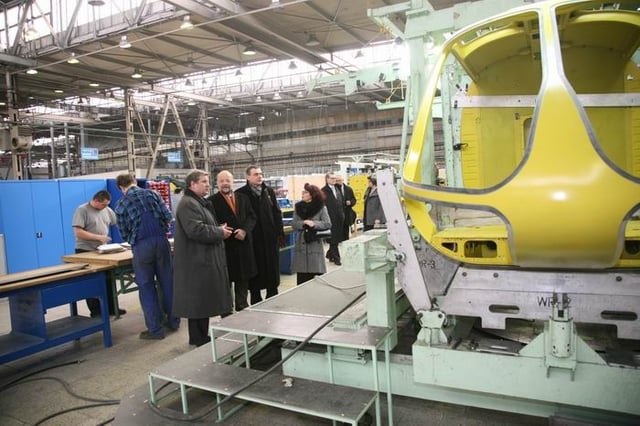
Polish MPs in the PZL Świdnik helicopter factory
The Lublin region is a part of eastern Poland, which has benefited less from the economic transformation after 1989 than regions of Poland located closer to Western Europe. Despite the fact that Lublin is one of the closest neighbour cities for Warsaw, the investment inflow in services from the Polish capital has secured a steady growth due to relatively fast connection, while external investments are progressing, enabling nearby satellite municipality Świdnik for large-scale industrial investments, seamlessly testing the capacity of the agglomeration. The close cooperation with Warsaw is significant to the regional economy, bringing quality cultural events inshore, yet the proximity of Warsaw is an underestimated asset.
Lublin is a regional center of IT companies. Asseco Business Solutions S.A., eLeader Sp z o.o., CompuGroup Medical Polska Sp. z o.o., Abak-Soft Sp. z o.o. and others have their headquarters here. Other companies (for example Comarch S.A., Britenet Sp. z o.o., Simple S.A., Asseco Poland S.A.) outsourced to Lublin, to take advantage of the educated specialists. There is a visible growth in professionals eager to work in Lublin, due to reasons, like quality of life, culture management, the environment, improving connection to Warsaw, levels of education, or financial, because of usually higher operating margins of global organizations present in the area.
The large car factory Fabryka Samochodów Ciężarowych (FSC) seemed to have a brighter future when it was acquired by the South Korean Daewoo conglomerate in the early 1990s. With Daewoo's financial troubles in 1998 related to the Asian financial crisis, the production at FSC practically collapsed and the factory entered bankruptcy. Efforts to restart its van production succeeded when the engine supplier bought the company to keep its prime market. With the decline of Lublin as a regional industrial centre, the city's economy has been reoriented toward service industries. Currently, the largest employer is the Maria Curie-Sklodowska University.
The price of land and investing costs are lower than in western Poland. However, the Lublin area has to be one of the main beneficiaries of the EU development funds.[16] Jerzy Kwiecinski, the deputy secretary of state in the Ministry for Regional Development at the Conference of the Ministry for Regional Development (Poland in the European Union — new possibilities for foreign investors) said:
In the immediate financial outlook, between 2007 and 2013, we will be the largest beneficiaries of the EU — every fifth Euro will be spent in Poland. In total, we will have at our disposal 120 billion EUR, assigned exclusively for post development activities. This sum will be an enormous boost for our country.[17]
In September 2007, the prime minister signed a bill creating a special economic investment zone in Lublin that offers tax incentives. It is part of “Park Mielec” — the European Economic Development area.[18] At least 13 large companies had declared their wish to invest here, e.g., Carrefour, Comarch, Safo, Asseco, Aliplast, Herbapol, Modern-Expo and Perła Browary Lubelskie.[19] At the same time, the energy giant Polska Grupa Energetyczna, which will build Poland's first nuclear power station, is to have its main offices in Lublin.
Modern shopping centers built in Lublin like Tarasy Zamkowe (Castle Terraces), Lublin Plaza, Galeria Olimp, Galeria Gala, the largest shopping mall in the city, covering 33,500 square meters of area. Similar investments are planned for the near future such as Park Felin (Felicity) and a new underground gallery ("Alchemy") between and beneath Świętoduska and Lubartowska Streets.[20]
Media
There is a public TV station in the city: TVP Lublin which owns a 104-meter-tall concrete television tower.[21] The station put its first program on the air in 1985. In recent years it contributed programming to TVP3 channel and later TVP Info.
The radio stations airing from Lublin include 'Radio eR - 87.9 FM', Radio 'Eska Lublin' - 103.6 FM, Radio Lublin (regional station of the Polish Radio) - 102.2 FM, [ Radio Centrum (university radio station)] - 98.2 FM, Radio 'Free' (city station of the Polish Radio) - 89,9 FM, and Radio 'Złote Przeboje' (Golden Hits) Lublin - 95.6 FM.
Local newspapers include Kurier Lubelski daily, regional partner of the national newspaper Dziennik Wschodni daily, Gazeta Wyborcza [ Lublin Edition] daily (regional supplement to the national newspaper Gazeta Wyborcza), [ Metro] (daily, free) and Nasze Miasto Lublin weekly (free).
Transport
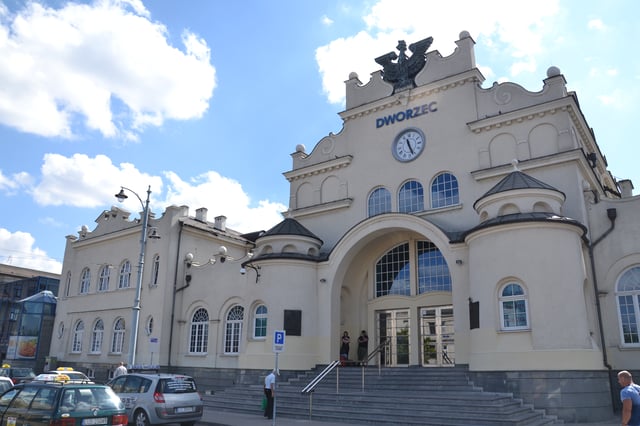
Lublin Train Station
From Lublin railway station, ten trains depart each day to Warsaw, and three to Kraków, as in other major cities in Poland. Lublin has also direct train connections with Rzeszów, Szczecin, Gdynia and other Polish cities and towns in the region as Nałęczów, Chełm or Zamość. Long-distance buses depart from near the Castle in the Old Town and serve most of the same destinations as the rail network. The express train to Warsaw takes about two and half hours.[22] The Lublin Airport is located in Świdnik, about 10 km (6.2 miles) SE of Lublin. There is a direct train link from the airport to downtown.
Roads
As of 2018, no motorways or expressways connect the city with the rest of Poland; currently, there is an expressway bypass around the city and two opposing stretches of highway to Warsaw and towards the border of Ukraine exist. However, in the next few years the construction of expressways S12, S17 and S19 will improve road access to the city. On 17 December 2009, the bidding process for the construction of S17 expressway around Lublin was started. The construction began in 2010 and was finished in 2014. The project included a high capacity bypass road around Lublin, removing most of the through traffic from the city streets and decreasing congestion. Furthermore, the construction of S17 in the direction of Warsaw is due to open in 2019 and the construction of S19 towards Rzeszów will begin.
Lublin is one of only four towns in Poland to have trolleybuses (the others are Gdynia, Sopot and Tychy).[23]
Culture and tourism
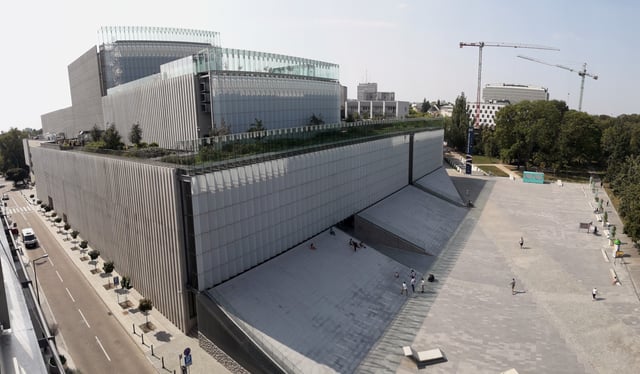
The Centre for the Meeting of Cultures and Teatralny Square, view from the Lublin Conference Center
Lublin is the largest city in eastern Poland and serves as an important regional cultural capital. Since then, many important international events have taken place here, involving Ukrainian, Lithuanian, Russian and Belarusian artists, researchers and politicians. The frescos at the Holy Trinity Chapel in Lublin Castle are a mixture of Catholic motifs with eastern Russian-Byzantine styles, reinforcing how the city connects the West with the East.
The arts
Museum
The premier museum in the city is the Lublin Museum, one of the oldest and largest museums of Eastern Poland, as well as the Majdanek State Museum with 121,404 visitors in 2011.[24]
Cinema
Lublin is a city with filmmaking past. A few important films were recorded here, e.g., Oscar-winning The Reader was partially filmed at the Nazi Majdanek concentration camp, in the boundaries of nowadays Lublin area.[25]
In 2008, Lublin in cooperation with Ukrainian Lviv, filmed promotional materials, to promote them as cinematic cities. Films were handed out between filmmakers present at Cannes Festival.[26] Action was sponsored by the European Union. There are movie theaters in Lublin including Cinema City (multiplex), Cinema Bajka, Cinema Chatka Żaka, and Cinema Medyk.
Theatres
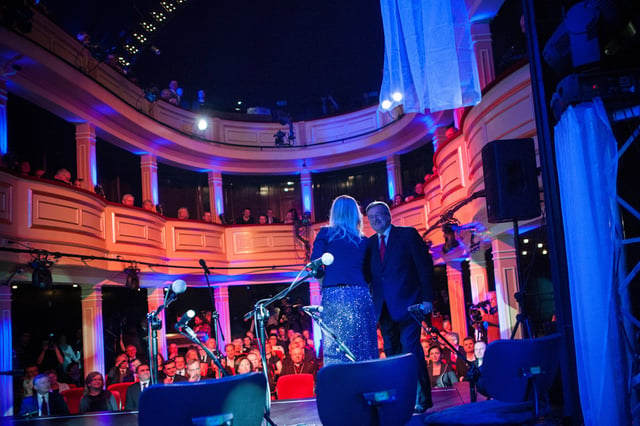
Old Theatre in Lublin, opening night
There are many cultural organizations in Lublin, either municipal, governmental and/or non-governmental. Among the popular venues are municipal theatres and playhouses such as:
Musical Theatre in Lublin - Teatr Muzyczny w Lublinie, opera, operetta, musical, ballet
Henryk Wieniawski Lublin Philharmonic - Filharmonia Lubelska
Juliusz Osterwa Theatre in Lublin - Teatr im. Juliusza Osterwy w Lublinie]
Hans Christian Andersen Theatre - with puppet programmes for children
Fringe theatres:
Centrum Projekt Pracovnia Maat
Centrum Kultury w Lublinie
Ośrodek Praktyk Teatralnych – Gardzienice
Ośrodek „Brama Grodzka - Theatre NN”
Galleries
There are numerous art galleries in Lublin; some are run by private owners, and some are municipal, government, NGO, or associations' venues. The Labyrinth Gallery, formerly "BWA", is the Artistic Exhibitions Office (Biuro Wystaw Artystycznych).
Old Town
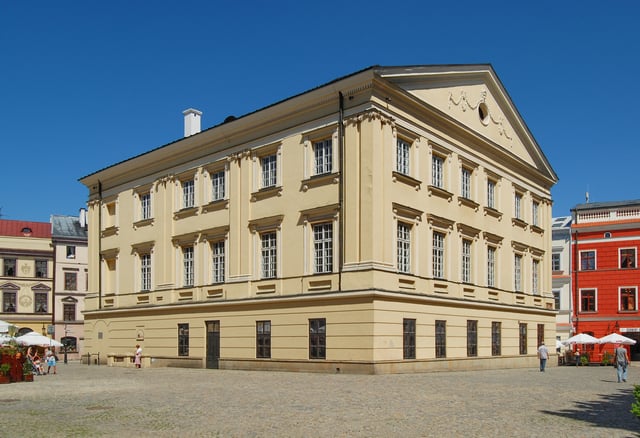
Crown Tribunal in the Old Town
Lublin, by some tourists can be called "a little Krakow", and this is true by the citizens sharing a number of Lesser Poland traditions, historic architecture and a unique ambiance, especially in the Old Town. Catering to students, who account for 35% of the population, the city offers a vibrant music and nightclub scene[27] Lublin has many theatres and museums and a professional orchestra, the Lublin Philharmonic.[28][29][30][31] Old buildings, even ruins, create a magic and unique atmosphere of the renaissance city. Lublin’s Old Town has cobbled streets and traditional architecture. Many venues around Old Town enjoy an architecture applicable for restaurants, art galleries, and clubs. Apart from entertainment this area has been designed to place small businesses and prestigious offices. The Church of St. Josaphat was built in 1786.
Pubs and restaurants
The Old Town Hall and Tribunal in the Market Square is surrounded by burgher houses and winding lanes.[32][33][34] In the Old Town and the immediate environs there are over 100 restaurants, cafes, pubs, clubs and other catering outlets, with cuisine of all kinds, ranging from haut cuisine to takeaways
City of festivals
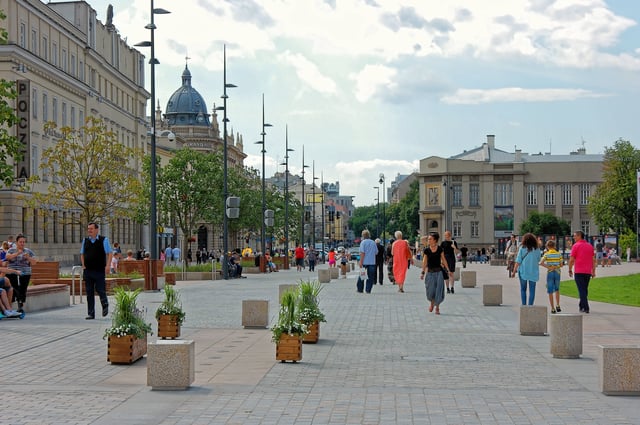
Litewski Square
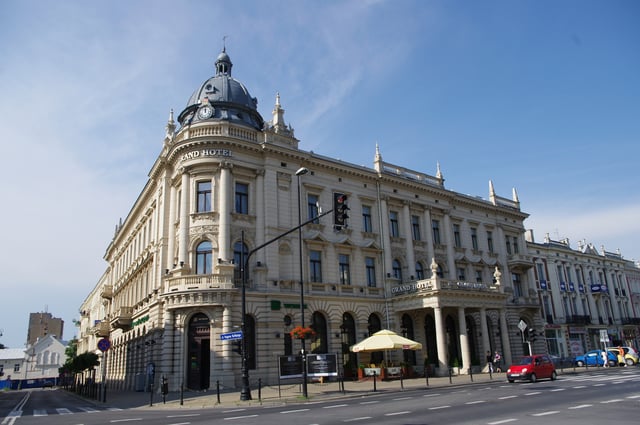
Grand Hotel Lublinianka
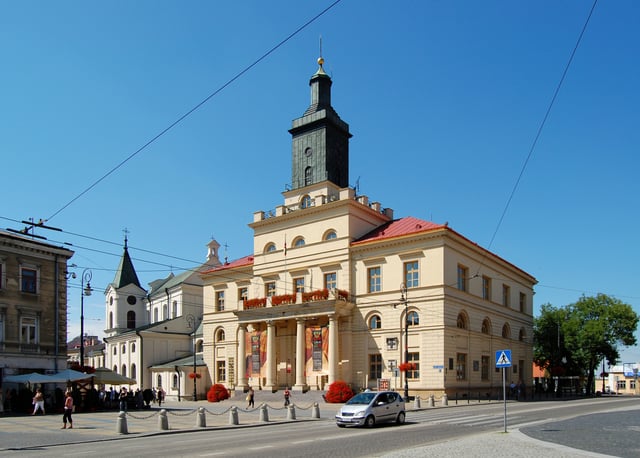
Lublin Town Hall
Lublin would like to be known as "the Capital of Festivals".[9] Every year a new festival appears. The most significant of them include:
Karnawał Sztuk-Mistrzów - Carnival Arts-Masters.
Noc Kultury - Night of Culture - usually the first Saturday night of June, hundreds of events in the whole city, cultural manifestation of city's potential; admission is free.[35]
OpenCity Festival - outdoor performances festival, international artists and performers, make art installations in public places in Lublin.[36]
Museum Night - like in whole world, Lublin's museums, are opened for visitors.
Jarmark Jagielloński - Jagiellonian Trades - every year, about 100k tourists, arrive in Lublin to feel a middle-age atmosphere.
Lubelskie Dni Kultury Studenckiej - an annual students' holiday, usually celebrated for about three weeks between May and June, students holiday in Lublin, are the longest in Poland.
Słowo daję - Festiwal Opowiadaczy - I give you my word. Storytellers Festival
Rozstaje Europy - International Festival of Document Film
Mikołajki Folkowe - International Folk Music Festival ("St. Nicholas Folk Day") - organized by the Maria Curie-Skłodowska University in Lublin.
Strefa Inne Brzmienia ("Different Sounds Area" International Music Festival, which connects Lublin and Lviv citizens together.
Lublin. Miasto Poezji - Poetry Festival organised by Ośrodek "Brama Grodzka - Teatr NN" and Polish Literature Institute of Catholic University in Lublin.
Noc z Czechowiczem - A Night with Czechowicz - walking the trace, from "Poem about the City of Lublin" written by Józef Czechowicz at first full moon in July, organized by Ośrodek "Brama Grodzka - Teatr NN"
Najstarsze Pieśni Europy - The oldest songs of Europe - Festival of Muzyka Kresów Foundation.
Future Shorts - World Short Film Label
Międzynarodowe Spotkania Teatrów Tańca - International Lublin Dance Festival
Międzynarodowy Festiwal Teatralny "Konfrontacje" - International Theatre Festival "Confrontations"
Festiwal Kultury Alternatywnej "ZdaErzenia" - Festival of Alternative Culture in Lublin
Sąsiedzi - Festiwal Teatrów Europy Środkowej - Neighbours - Central European Theatres Festival
Festiwal "Prowokacje" - Young Polish Fashion Creators Festival
Studencki Ogólnopolski Festiwal Teatralny Kontestacje - Polish Students' Theatre Festival
Międzynarodowe Spotkania Folklorystyczne im. Ignacego Wachowiaka - International Folk Dance Festival
Lubelska Scena Rockowa - Lublin Rock Scene
Taniec Znaku - first in Poland Internet Theatre, project of Lublin Maat Theatre,[37]
Scena Młodych - Youth Scene, music festival
Zwierciadła - Mirrors - High School Theatres Revision
Zaduszki Jazzowe - Jazz All Souls' Day - it takes place in Dominican Order Monastery
"Invitro" Scena Prapremier - "Invitro" Pre-première Scene[38]
Solo życia - Classical Music Festival - creator of this festival is composer Mieczysław Jurecki
Letnia Strefa Muzyki - Summer Music Area - Young Polish musicians, promotion, on the small scene, organizers: Akwarela Cafe and Lublins' President Council
European Capital of Culture
In 2007, Lublin joined the group of Polish cities as candidates for the title of European Capital of Culture. Lublin won through to shortlisting and was considered a dark horse of that competition. Ultimately Wrocław was chosen.
Lublin is the city that symbolises European idea of integration, universal heritage of democracy and tolerance and the idea of dialogue between the cultures of the West and East. Lublin is a unique place where the cultures and religions meet. Here the East meets West, and the European Union meets Belarus and Ukraine. It is the perfect place of cooperation for European artists living within and outside the European Union. Lublin is a city open to artists, a place where unique initiatives and activities take place. Lublin means the experience of hundreds of years of rich history and cultural heritage which constitutes endless source of inspiration for new generations. European Culture is not only modern museums and enormous festivals, but first of all people and their activities, aims, aspirations, possibilities, potential and the desire for development. The development of culture and being granted the title of European Capital of Culture is a chance for development of one the poorest regions of the European Union."[39] — Adam Wasilewski, President of Lublin
Since 2007, there are special meetings, enter2016, which anyone could take part in. The city's Marketing Office have created a website: Lublin2016.eu [57] , available in Polish, English, Ukrainian, Spanish and Portuguese. Lublin is a pilot city of the Council of Europe and the European Commission Intercultural cities programme.
Sports

Arena Lublin
Start Lublin – men's basketball team, 12th in Era Basket Liga in 2003–04 season.
MKS Lublin – women's handball team playing in Polish Ekstraklasa Women's Handball League: 2nd place in 2003–04 season: also a winner of Women's EHF Cup in season 2000-01.
Motor Lublin – professional football team competing in the Polish 3rd league (as of 2016).
Lublinianka – men's football team competing in the Polish 4th league (as of 2016).
Budowlani Lublin – a local rugby union team competing in the Polish, and surrounding district league.
Speed Car Motor Lublin – speedway club competing in the Polish league (first division).
LSKT – Lublin's Taekwon-do sport club.
Tytani Lublin – semi-professional American football team
International events
2019 FIFA U-20 World Cup
Education
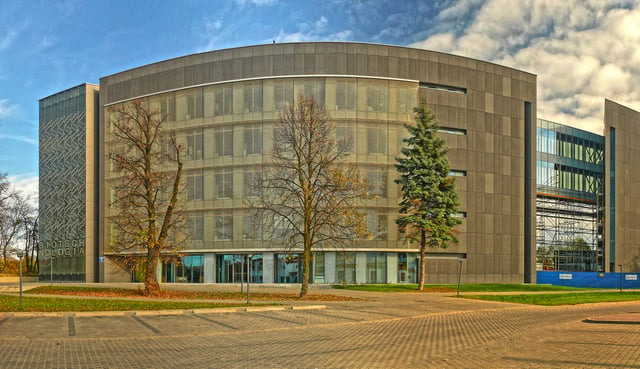
Faculty of Biotechnology, KUL
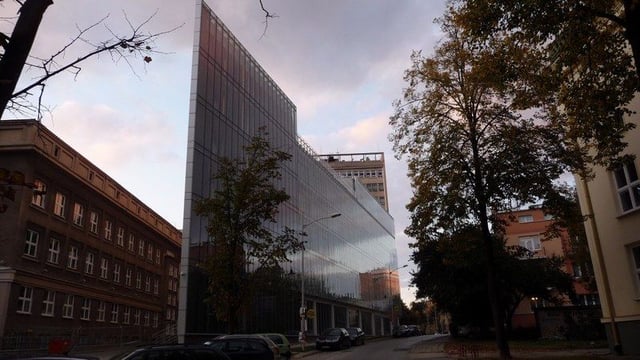
Faculty of Information Technology, UMCS
There are five public schools of higher education:
Maria Curie-Sklodowska University (UMCS)
John Paul II Catholic University of Lublin (KUL)
Medical University of Lublin
University of Life Sciences in Lublin
Politechnika Lubelska
Lublin is home to private higher education establishments.
University of Economics and Innovation in Lublin
Lubelska Szkoła Biznesu
Wyższa Szkoła Nauk Społecznych z siedzibą w Lublinie
Wyższa Szkoła Przedsiębiorczości i Administracji
Vincent Pol University in Lublin
It is home to one of the oldest still functioning schools in Poland, The Staszic School , which was established in 1586. The school has many notable
alumni, such as Bolesław Prus, one of the most influential Polish writers and novelists, or Lesław Paga, the co-founder of the Warsaw Stock Exchange.
Politics
Members of Parliament elected from District 6 which consists of the City of Lublin.[40]
Joanna Mucha (43 459)
Włodzimierz Karpiński (10 260)
Wojciech Wilk (6 348)
Jakub Kulesza (15 058)
Elżbieta Kruk (43 432)
Gabriela Masłowska (23 287)
Sylwester Tułajew (17 289)
Artur Soboń (16 643)
Jarosław Stawiarski (15 807)
Krzysztof Michałkiewicz (15 806)
Lech Sprawka (15 713)
Krzysztof Głuchowski (9 924)
Krzysztof Szulowski (9 019)
Jerzy Bielecki (8 510)
Notable Members of Parliament (Sejm) elected from Lublin constituency:
Zyta Gilowska, PiS
Stanisław Głębocki, Samoobrona
Arkadiusz Kasznia, SLD-UP
Elżbieta Kruk, PiS
Grzegorz Kurczuk, SLD-UP
Robert Luśnia, LPR
Andrzej Mańka, PiS
Gabriela Masłowska, LPR
Krzysztof Michałkiewicz, PiS
Wiktor Osik, SLD-UP
Zdzisław Podkański, PSL
Tadeusz Polański, PSL
Izabella Sierakowska, SLD-UP
Zygmunt Jerzy Szymański, SLD-UP
Leszek Świętochowski, PSL
Marian Widz, Samoobrona
Józef Żywiec, Samoobrona
Members of the European Parliament elected from the Lublin constituency include Lena Kolarska-Bobińska.
International relations
Lublin is a pilot city of the Council of Europe and the EU Intercultural cities programme.[41]
Twin towns — sister cities
|




